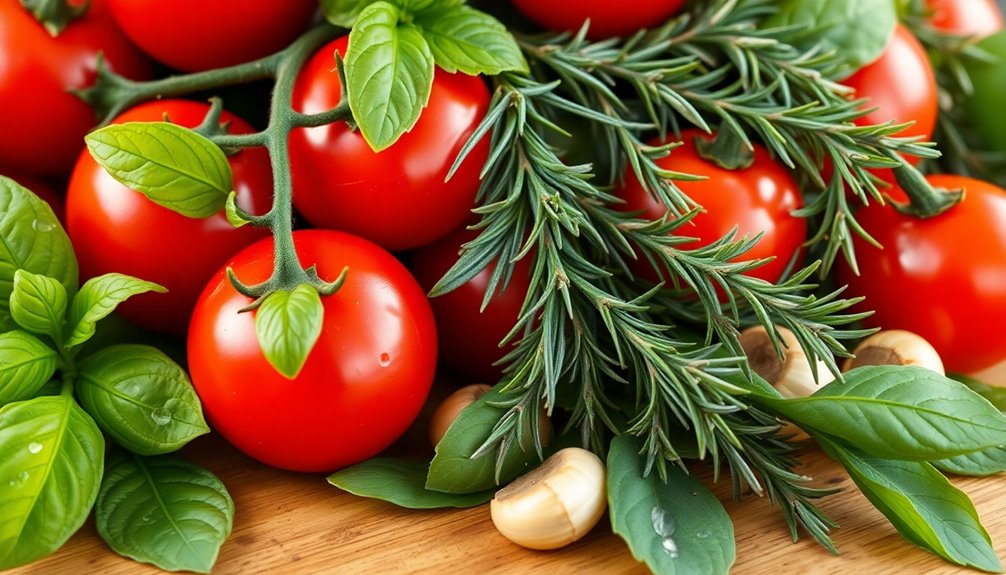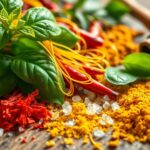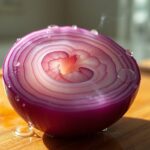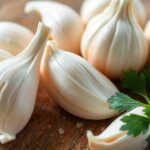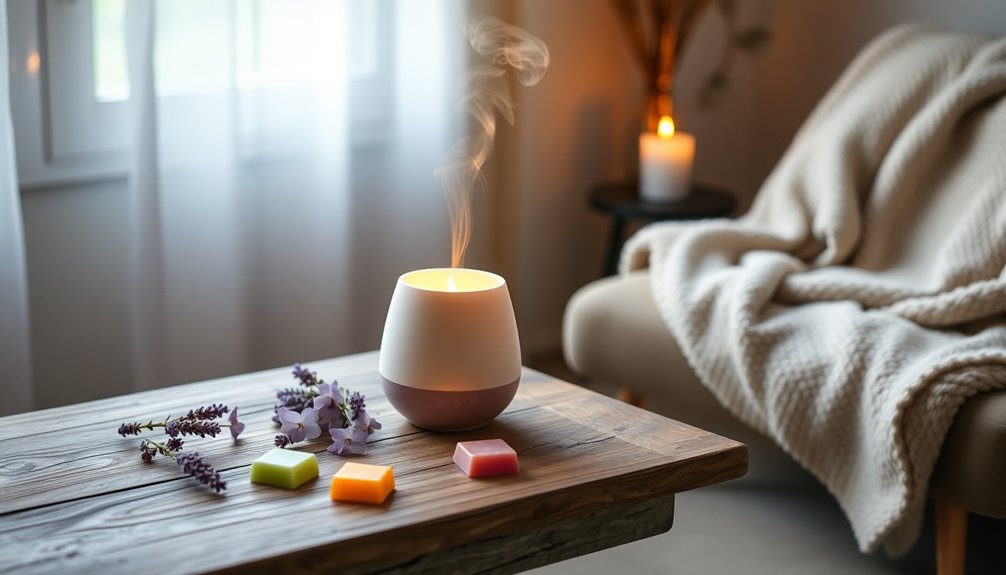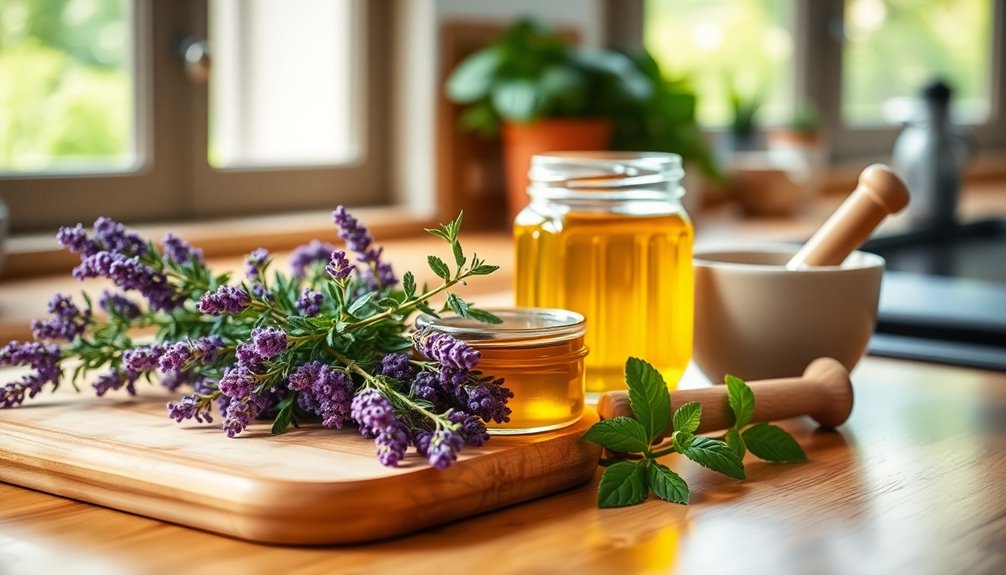Aromatic vegetables are the flavorful essentials in your kitchen, bringing life to many dishes. Think of onions, garlic, celery, and leeks; they possess strong scents that enhance your meals. These vegetables form the foundation for stocks, soups, and sauces, making them indispensable. When combined, they create classic blends like mirepoix or the Cajun holy trinity, adding depth to your cooking. Not only do they elevate flavors, but they also offer health benefits packed with vitamins and antioxidants. If you want to discover more about how to use them effectively, you won't want to miss what's next!
Key Takeaways
- Aromatic vegetables possess strong, distinctive scents that enhance flavors in various dishes, serving as a culinary foundation.
- Common examples include onions, garlic, leeks, carrots, celery, and bell peppers, each contributing unique flavor profiles.
- They are essential in creating flavor bases like mirepoix and the Cajun holy trinity, elevating meal enjoyment.
- Aromatics provide nutritional benefits, being rich in antioxidants, vitamins, and minerals, supporting overall health.
- Proper storage and usage are important for freshness, with some aromatics like garlic being suitable for freezing.
Definition of Aromatic Vegetables
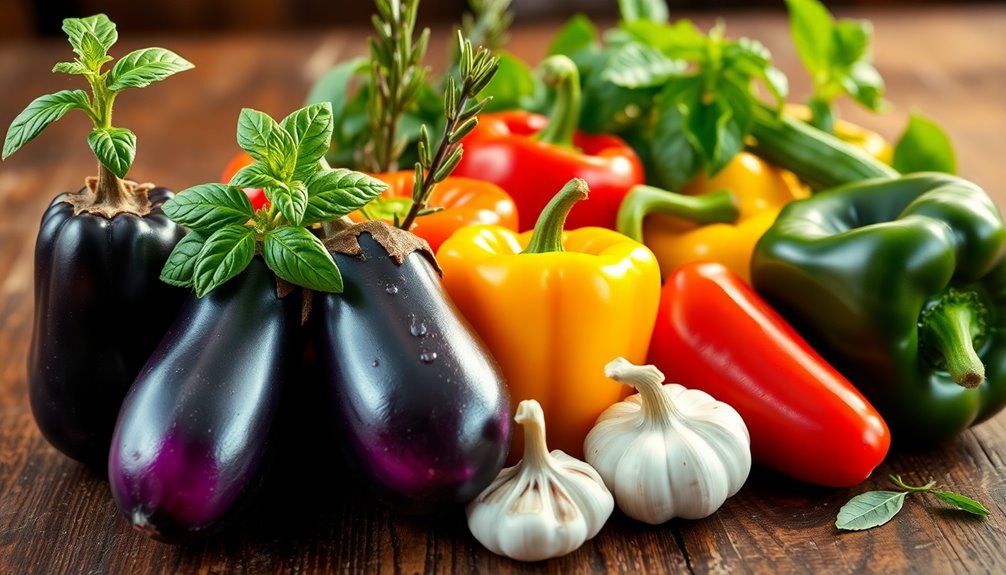
Aromatic vegetables are the culinary backbone of many dishes, releasing bold flavors and enticing fragrances when cooked. These ingredients, often the first sautéed in oil or butter, create a robust flavor base essential for soups, stocks, sauces, and stir-fries.
Common aromatics include chopped onions, garlic, leeks, carrots, celery, and bell peppers, each adding unique notes to your meals. You can combine these vegetables in specific ratios, like the French mirepoix (2:1:1 of onions, carrots, and celery) or the Cajun holy trinity (2:1:1 of onions, celery, and bell peppers).
Types of Aromatic Ingredients
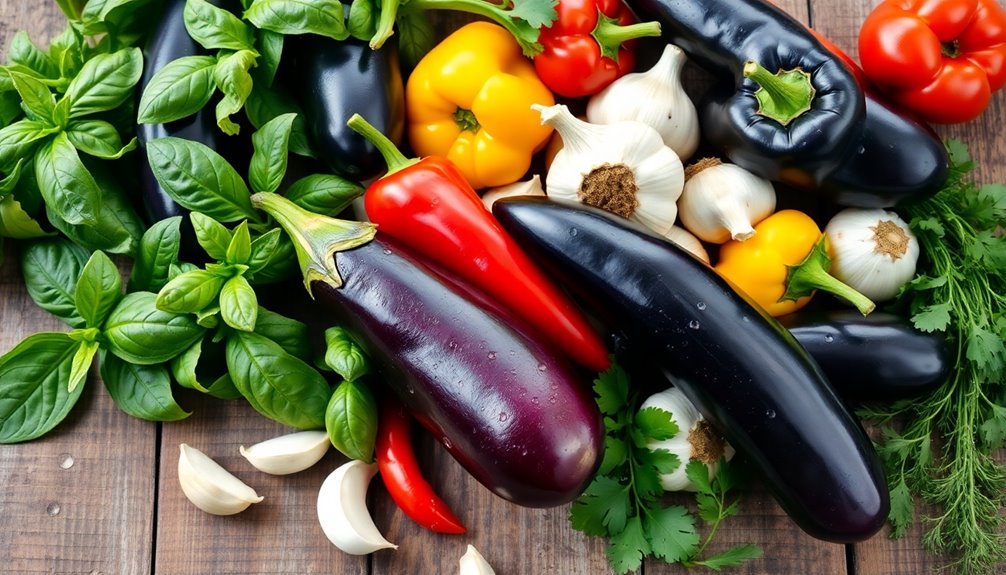
When you think about aromatic vegetables, you'll notice a variety of flavors that enhance your dishes.
From the onion family to the sweetness of carrots and the bite of garlic, these ingredients play an essential role in many cuisines.
Understanding how to use them in different cooking techniques can elevate your meals to a whole new level.
Common Aromatic Vegetables
Onions, carrots, celery, and garlic form the backbone of countless dishes, infusing meals with essential flavors. These common aromatic vegetables are vital for creating robust, enjoyable meals.
The onion family, which includes bulb onions, shallots, and leeks, adds both sweetness and astringency to your recipes. Carrots contribute sweetness along with a hint of earthiness, making them key in classics like mirepoix.
Celery balances flavors beautifully in soups and stocks, softening during cooking to blend seamlessly with other aromatics.
- Bell peppers add sweetness and texture.
- Ginger offers a unique, pungent flavor.
- Leeks enhance dishes with a mild onion taste.
- Shallots provide a subtle, sweet onion flavor.
Incorporate these vegetables into your cooking for a flavor boost! Additionally, using these aromatic ingredients can enhance mood and emotional well-being by creating a more inviting atmosphere in your kitchen.
Aromatics in Different Cuisines
In many cuisines around the world, the right combination of aromatic ingredients elevates dishes to new heights.
In French culinary tradition, mirepoix—a blend of onions, celery, and carrots—is commonly used as a flavor base.
Italian cooks often turn to soffritto, which features these same vegetables sautéed in olive oil.
The Cajun holy trinity swaps carrots for green bell peppers, enhancing dishes like jambalaya and gumbo.
Meanwhile, in Spanish cuisine, sofrito combines onions, garlic, and bell peppers, sometimes enriched with tomatoes, to create depth.
Asian cooking frequently employs an aromatic combination of garlic, ginger, and green onions, vital for stir-fries and soups.
These aromatic ingredients are essential for capturing the unique flavor and aroma of each dish.
#
Cooking Techniques for Aromatics
Revealing the full potential of aromatic vegetables transforms your cooking.
These aromatics are vegetables like onions, garlic, carrots, and celery, which serve as a crucial flavor base in dishes like chicken soup.
Mastering cooking techniques can elevate your meals considerably:
- Sautéed in oil or butter to release flavors
- Using a two-stage process for sturdier and delicate aromatics
- Maintaining uniform cuts for even cooking
- Adapting combinations like the French mirepoix (equal parts onions, carrots, celery)
Common Aromatic Combinations
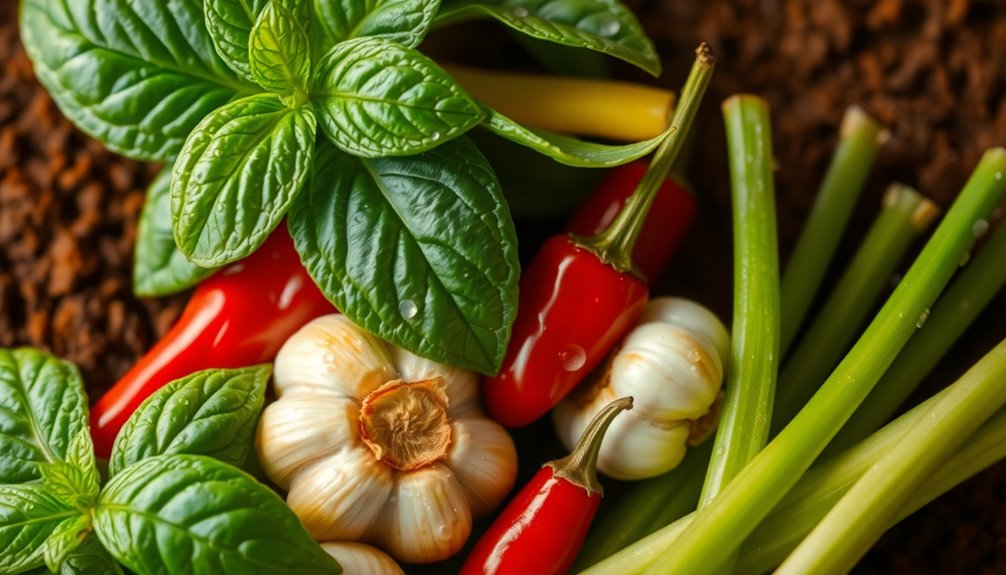
When you're looking to elevate your dishes, understanding common aromatic combinations can make all the difference.
The classic French mirepoix—onions, carrots, and celery in a 2:1:1 ratio—is a foundational flavor base for soups and stews.
If you're craving something Southern, the Cajun holy trinity of onions, green bell peppers, and celery is essential for gumbo and jambalaya.
For Hispanic recipes, Spanish sofrito combines onions, bell peppers, and garlic, sautéed in oil to create depth.
Italian soffritto features onions, carrots, and celery, perfect for sauces and risottos.
In Asian cuisines, a mix of garlic, ginger, and green onions adds flavor to stir-fries and soups.
These popular aromatics truly enhance your culinary creations! Additionally, understanding how to manage expenses abroad can further improve your cooking experience by allowing you to invest in quality ingredients.
## Cooking Techniques for Aromatics

To truly release the flavors of your dishes, mastering the cooking techniques for aromatics is essential. Start by sautéing classic aromatics like onions and carrots in fat, such as oil or butter, to develop a rich base.
Different stages of cooking are needed; cook tougher aromatics first before adding delicate ones like garlic and ginger.
- Cut your aromatics uniformly for even cooking.
- Sauté for about 10-15 minutes, depending on the recipe calls for.
- Consider bundling herbs and spices in a sachet for easy removal in broth or stock.
- Adjust cooking time to achieve your desired aroma and flavor intensity.
These techniques will elevate your dishes and enhance their overall taste!
Recipes Featuring Aromatics
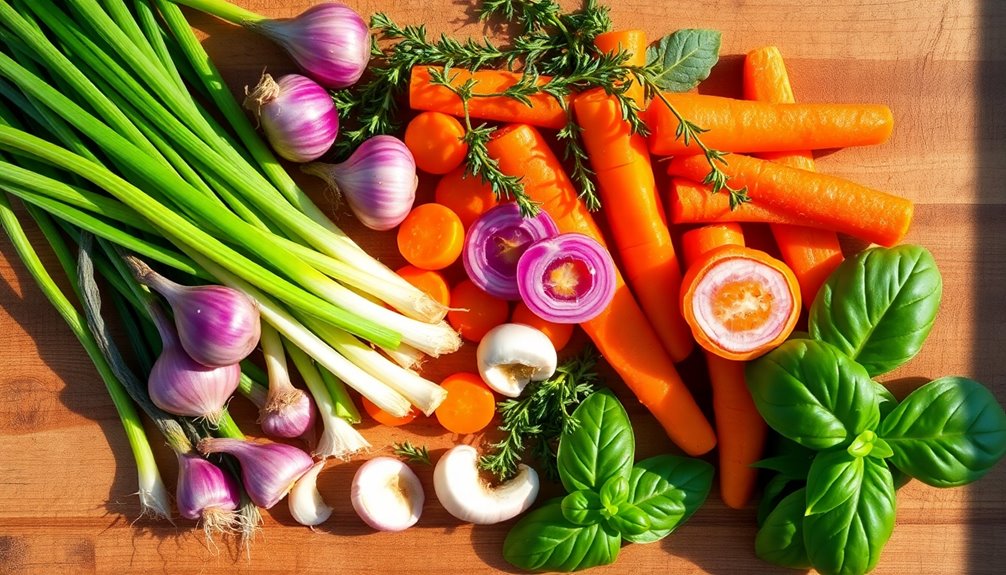
How can you elevate your culinary creations with the vibrant flavors of aromatics? Start by incorporating a mirepoix of onions, carrots, and celery in your homemade soup.
Sautéed until fragrant, these aromatics form the perfect base for dishes like chicken noodle soup. For an even richer aroma, layer your aromatics throughout the cooking process. Additionally, using aromatics like garlic and ginger can provide health benefits due to their antioxidant properties, which support overall well-being.
In sauces like espagnole, add them at different stages to build depth. Stir-fries and curries also shine with early additions of garlic and ginger, releasing maximum flavor. Additionally, the greatest happiness principle suggests that enhancing the sensory experience of food can contribute to overall well-being.
Storage and Shelf Life
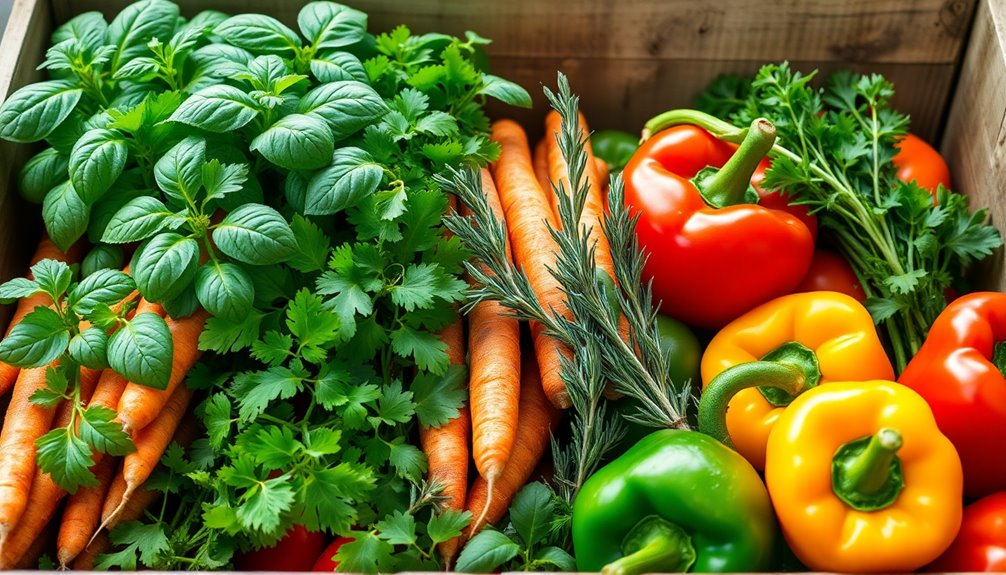
Properly storing aromatic vegetables is essential to maintaining their vibrant flavors and nutritional value. Most aromatic vegetables, like onions and garlic, can be kept in a cool, dark, dry place for several weeks.
However, leafy aromatics such as celery need refrigeration.
- Store celery and parsley in a sealed bag or container for up to a week.
- Use chopped or minced aromatic vegetables within 1-2 days to prevent spoilage.
- Freezing herbs and garlic can extend their shelf life for several months.
- Always label stored aromatic vegetables with the date to monitor freshness.
Additionally, storing these vegetables properly can help reduce allergen reduction in your kitchen environment.
Enhancing Flavor in Dishes
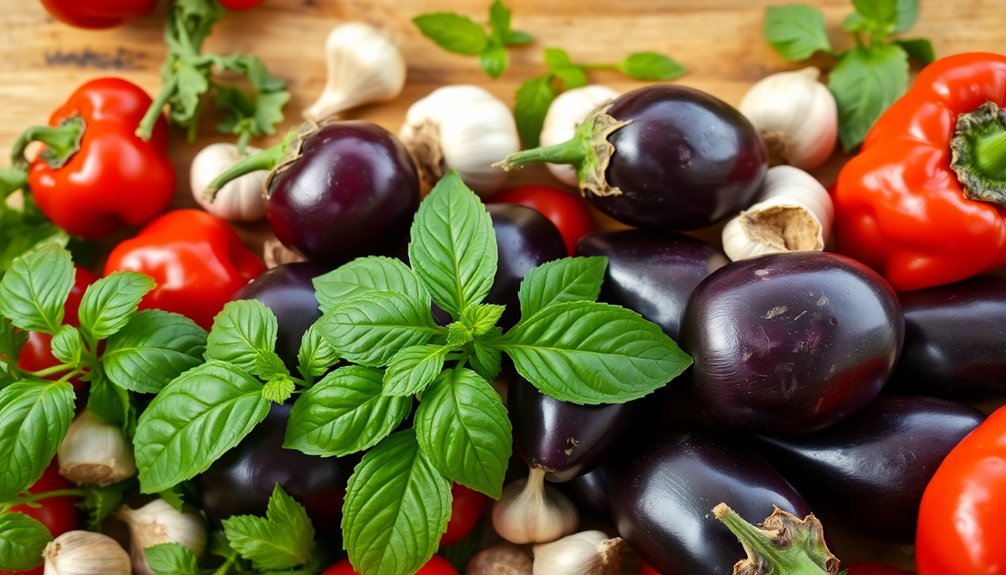
Aromatic vegetables are the backbone of flavorful cooking, as they release essential oils and compounds that elevate the taste and aroma of your dishes. When you sauté these vegetables, like onions, garlic, carrots, and celery, you reveal their flavors, vital for enhancing soups, sauces, and stews. The classic French mirepoix (2:1:1 ratio of onions, celery, and carrots) provides a balanced flavor profile, similar to how pet therapy can enhance emotional well-being in patients by providing comfort and companionship. Additionally, using essential oils for respiratory health can further enhance your cooking experience by infusing your dishes with aromatic benefits. Understanding the mechanics of French press coffee can inspire you to explore new flavors in your culinary creations. Incorporating antioxidants from these vegetables not only boosts flavor but also enhances the nutritional value of your meals.
| Aromatic Vegetable | Flavor Profile | Common Use |
|---|---|---|
| Onions | Sweet, savory | Base for soups |
| Garlic | Pungent | Sautéed dishes |
| Celery | Fresh, crisp | Mirepoix blend |
Layering these vegetables at different cooking stages helps develop complex flavors, making your meals truly satisfying. Essential oils from these vegetables can also enhance the overall sensory experience of your dishes. Next time you visit the grocery store, don't forget these essential ingredients!
Frequently Asked Questions
What Is an Aromatic Vegetable?
An aromatic vegetable is one that releases strong and pleasant flavors when cooked.
When you sauté these vegetables, like onions or garlic, they enhance the dish's overall taste. You'll often find them in the base of soups and sauces, providing depth and complexity.
Using a combination, like mirepoix, can elevate your cooking. Pay attention to how you cut and cook them, as it greatly affects the flavors in your meal.
What Are the Most Aromatic Vegetables?
When you think about the most aromatic vegetables, consider onions, garlic, and carrots as top contenders. Onions bring depth and a savory quality, while garlic adds a robust flavor that enhances any dish.
Carrots, with their natural sweetness, balance the mix perfectly. Don't overlook celery, which offers a fresh bite, or bell peppers, providing a mild sweetness.
Ginger can't be ignored either, delivering a spicy kick that elevates Asian cuisines.
What Does Aromatic Mean in Food?
You might think "aromatic" just refers to pleasant smells, but in food, it's deeper.
Aromatic means ingredients that release intense, flavorful scents when cooked, enhancing your dish's overall taste. These vegetables contain natural oils and compounds that bring complexity and richness.
When you sauté them, you activate those flavors, creating a fragrant base for your meals.
Which of the Following Is an Aromatic Vegetable?
When you're identifying aromatic vegetables, think about ingredients that enhance flavors in your dishes. Onions, garlic, carrots, and celery are classic examples.
These veggies create a rich base for many recipes. For instance, you might use onions for their pungency or carrots for their sweetness.
If you're preparing a soup or stew, remember that using a combination like onion, celery, and carrot can elevate your dish and create a harmonious flavor profile.
Conclusion
Incorporating aromatic vegetables into your cooking not only elevates flavors but also boosts your health. Did you know that studies show eating a diet rich in aromatic herbs and vegetables can reduce the risk of chronic diseases by up to 30%? By embracing these vibrant ingredients, you're not just enhancing your meals; you're investing in your well-being. So, next time you're in the kitchen, reach for those aromatic veggies and savor the delicious benefits they bring!

